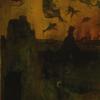
Posted
Working with the Synchron smart orchestra means that multiple instruments in different octave layouts can be played on the keyboard.
Would be very helpful if in the figure editor there is an extension for main lines that are on the octave positions above the standard two octave positions in the figure editor.
On the zero line( center line) are 1 octave above and 1 octave below with a division in lines and above and below come then 2 or 3 new horizontal octave lines.
This seems very user-friendly and convenient for composing.
See enclosed pic : the redarrow is in reality a thin white line , the same as the zero line (middle line)

Tue, 2023-09-26 - 10:10 Permalink
Yes, so at a given scale, the steps are fixed.
Whether the figure knows where the octave is not important to me : I can position my figure in the vicinity of an octave line (or on it) and that's what matters.
The octave line acts only as a visual aid to work with higher octave ranges in the phrase editor.
Now that the scales dictate the steps, it is possible to determine the octave step lines for the higher octaves from this alone.
Two octave step lines above and below the existing octave lines are sufficient I suppose.
Another idea is to accentuate the octave step lines in order to place the phrase in a more user-friendly way (shift in pitch).
Tue, 2023-09-26 - 11:56 Permalink
Hope this new usability in the phrase editor will get there that I suggested.
Plan to start replacing the playingranges I don't see it happening in Synfire so soon.
Would be better for composing though to see where each instrument is in terms of pitch.
But continue with the existing system of playing ranges and make it more user friendly.
Tue, 2023-09-26 - 15:30 Permalink
not sure how this will help given the note actually played depends on the playing range of the instrument, the 'sweet spot' of the instrument, which playing range the phrase is tagged in (low, mid or high - which is shown on the display), the interpretation settings, the vertical and horizontal scales and the setting of the transpose parameter.
It definitely won't help with with your specific instrument with a keyboard split point. You are better separating out the different phrases into two instrument 'tracks'.
It will increase the screen space taken up by each instrument and force users to scroll up and down more.
Tue, 2023-09-26 - 15:49 Permalink
<It definitely won't help with your specific instrument with a keyboard split point. You are better separating out the different phrases into two instrument 'tracks.
Yes, that also happens that two instruments are recorded on their own track.
On one instrument I play the keyboard range and on the other track also a specific keyboard range
The Synchron player Vst for the Smart Orchestra library has different instruments lying across the keyboard at the same time in different octave pitches
Special the solo instruments are situated in the high registers and therefore i do need some help in the phrase editor
Tue, 2023-09-26 - 18:08 Permalink
I've never seen a setup like that but havent used that particular vst. Normally the keyboard is split into multiple ranges with each playing on its own channel (I'm old school, or maybe just old).
However, given what you've described, I'd just make three synfire tracks and select to use the same instrument each time. Define the three playing ranges (low, mid and high) so they don't overlap and correspond to the 3 different midi note ranges used by the vst to play the 3 different instruments. On the first track set the figures to the low range, on the second, set them to the middle range and on the third set them to the high range. This will continue to work even if on the vst you pitch down or up any of the sounds.
Tue, 2023-09-26 - 20:03 Permalink
Is a good approach , only am not really handy with setting the playranges
I was trying to avoid that by using those octave lines.
Surely a feedback is needed with the Smart Orchestra keyboard to know in which octaves will be played.
Problem though is the Smart Orchestra is CPU hungry, and a Smart Orchestra vst has to be set up for each instrument.
At the moment the SO ( smart orchestra ) is actually not usable in Synfire on my computer system, but still usable on the Vienna ensemble pro server with 10 tracks
The software developer of SO should start improving this, or it has to do with the audio engine of Synfire ?
Tue, 2023-09-26 - 20:48 Permalink
If you don't like setting up playing ranges to separate the octaves you could also use the Chromatic parameter for this. So, you could setup multiple tracks which are all assigned to the same VST (as blacksun suggested) and instead of setting up different playing ranges you could choose different values for the Chromatic parameter (-24, -12, 0, 12, 24, etc) for each track. Then draw the figures around the center line for each track and they will be transposed to the right octave by the Chromatic setting.
Tue, 2023-09-26 - 23:10 Permalink
Yes, is a possible nice way to go into the right octave register to record with the keyboard or via drawing the figures.
Will try to make it sometime this setup and see how it works.
Low , middle and high register : what do the chromatic parameter values stand for ?
The 0 value stands for the middle C ?
Wed, 2023-09-27 - 08:13 Permalink
what do the chromatic parameter values stand for ?The 0 value stands for the middle C ??
0 value stands for no transposition, 12 stands for transposition one ocave up, -12 one octave down, etc. This transposition is independent of the playing range settings.
Wed, 2023-09-27 - 21:25 Permalink
Thanks, going to try it out.
I am now working on putting Synfire and libraries on faster storage , would then be 5 x faster than now and hopefully more Smart Orchestra plugins can be used then.
I would have liked to have seen in the phrase editor a few more octave helpline
there.
But you cannot get always what you want.
For example at +-12, +-24 and +-36
These are not in the way and can be used as a 4th method and for placement of phrases in the phrase editor.
This only applies to the Smart Orchestra vst plugin.
- standard phrase editor
- split in registers instruments (low, middle and high playrange)
- via chromatic parameter.
- auxiliary octave lines in phrase editor




